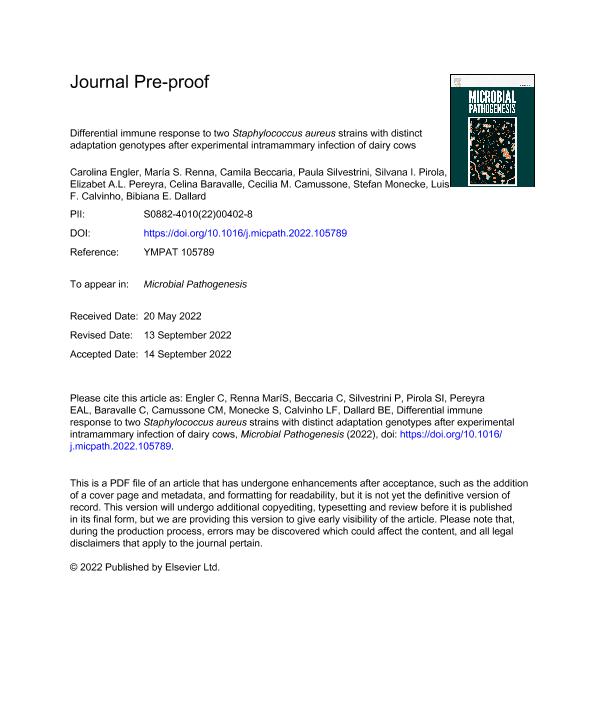Artículo
Differential immune response to two Staphylococcus aureus strains with distinct adaptation genotypes after experimental intramammary infection of dairy cows
Engler, Carolina ; Renna, Maria Sol
; Renna, Maria Sol ; Beccaría, Camila
; Beccaría, Camila ; Silvestrini, Paula
; Silvestrini, Paula ; Pirola, Silvana Inés
; Pirola, Silvana Inés ; Pereyra, Elizabet Amanda Lorena
; Pereyra, Elizabet Amanda Lorena ; Baravalle, Celina
; Baravalle, Celina ; Camussone, Cecilia María
; Camussone, Cecilia María ; Monecke, Stefan; Calvinho, Luis Fernando; Dallard, Bibiana Elisabet
; Monecke, Stefan; Calvinho, Luis Fernando; Dallard, Bibiana Elisabet
 ; Renna, Maria Sol
; Renna, Maria Sol ; Beccaría, Camila
; Beccaría, Camila ; Silvestrini, Paula
; Silvestrini, Paula ; Pirola, Silvana Inés
; Pirola, Silvana Inés ; Pereyra, Elizabet Amanda Lorena
; Pereyra, Elizabet Amanda Lorena ; Baravalle, Celina
; Baravalle, Celina ; Camussone, Cecilia María
; Camussone, Cecilia María ; Monecke, Stefan; Calvinho, Luis Fernando; Dallard, Bibiana Elisabet
; Monecke, Stefan; Calvinho, Luis Fernando; Dallard, Bibiana Elisabet
Fecha de publicación:
09/2022
Editorial:
Academic Press Ltd - Elsevier Science Ltd
Revista:
Microbial Pathogenesis
ISSN:
0882-4010
Idioma:
Inglés
Tipo de recurso:
Artículo publicado
Clasificación temática:
Resumen
The aim of this study was to evaluate and compare the ability of two S. aureus strains with different adaptation genotypes (low and high) to the bovine mammary gland (MG) to establish an intramammary infection (IMI) and induce an immune response after an experimental challenge in lactating cows. Two isolates (designated 806 and 5011) from bovine IMI with different genotypic profiles, harboring genes involved in adherence and biofilm production, belonging to different capsular polysaccharide (CP) type, accessory gene regulator (agr) group, pulsotype (PT) and sequence type/clonal complex (ST/CC) were selected. Strains 806 and 5011 were associated with low (nonpersistent-NP) and high (persistent-P) adaptation to the MG, respectively. Strain 806 (NP) was characterized as agr group II, cap5 positive and ST350; strain 5011 (P) agr group I, cap8 positive and CC188. Three groups of clinically healthy cows, 4 cows/treatment group, were inoculated by the intramammary route with strain 806 (NP), strain 5011 (P) and pyrogen-free saline solution. All mammary quarters challenged with strain 806 (NP) developed mild clinical mastitis between 1 and 7 d post inoculation (pi). Quarters challenged with strain 5011 (P) developed a persistent IMI; bacteria were recovered from milk from d 7 pi and up to d 56 pi. In quarters inoculated with strain 806 (NP) the inflammatory response induced was greater and earlier than the one induced by strain 5011 (P), since a somatic cell count (SCC) peak was observed at d 2 pi, while in quarters inoculated with strain 5011 (P) no variations in SCC were observed until d 4 pi reaching the maximum values at d 14 pi; indicating a lower and delayed initial inflammatory response. The highest levels of nitric oxide (NO) and lactoferrin (Lf) detected in milk from quarters inoculated with both S. aureus strains coincided with the highest SCC at the same time periods, indicating an association with the magnitude of inflammation. The high levels of IL-1β induced by strain 806 (NP) were associated with the highest SCC detected (d 2 pi); while quarters inoculated with strain 5011 (P) showed similar IL-1β levels to those found in control quarters. In quarters inoculated with strain 806 (NP) two peaks of IL-6 levels on d 2 and 14 pi were observed; while in quarters inoculated with strain 5011 (P) IL-6 levels were similar to those found in control quarters. The strain 806 (NP) induced a higher total IgG and IgG1 response; while strain 5011 (P) generated a higher IgG2 response (even against the heterologous strain). The present study demonstrated that S. aureus strains with different genotype and adaptability to bovine MG influence the local host immune response and the course and severity of the infectious process.
Archivos asociados
Licencia
Identificadores
Colecciones
Articulos (IDICAL)
Articulos de INSTITUTO DE INVESTIGACION DE LA CADENA LACTEA
Articulos de INSTITUTO DE INVESTIGACION DE LA CADENA LACTEA
Articulos(ICIVET-LITORAL)
Articulos de INST. DE CIENCIAS VETERINARIAS DEL LITORAL
Articulos de INST. DE CIENCIAS VETERINARIAS DEL LITORAL
Citación
Engler, Carolina; Renna, Maria Sol; Beccaría, Camila; Silvestrini, Paula; Pirola, Silvana Inés; et al.; Differential immune response to two Staphylococcus aureus strains with distinct adaptation genotypes after experimental intramammary infection of dairy cows; Academic Press Ltd - Elsevier Science Ltd; Microbial Pathogenesis; 172; 9-2022; 1-13
Compartir
Altmétricas



